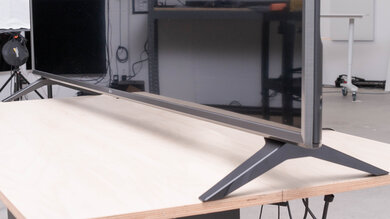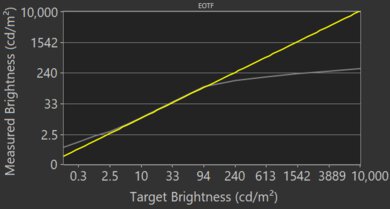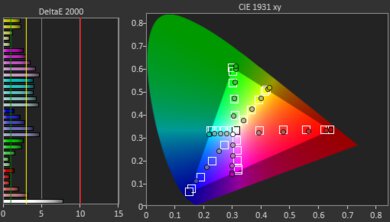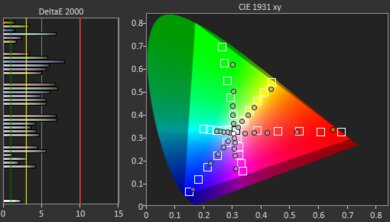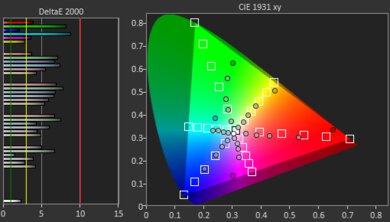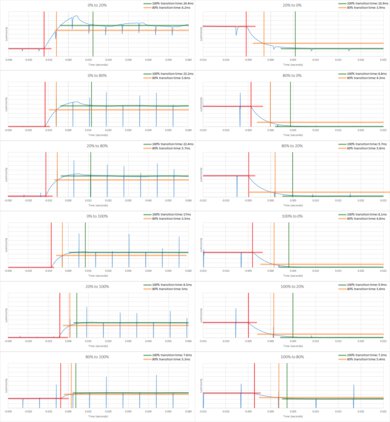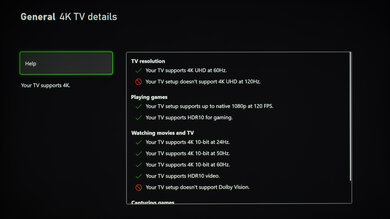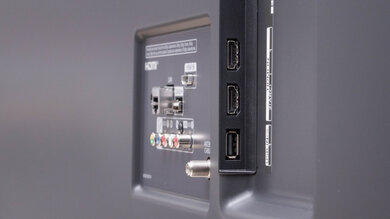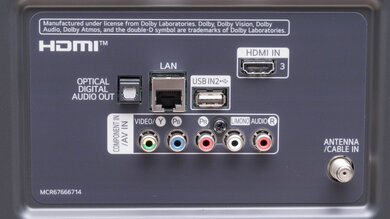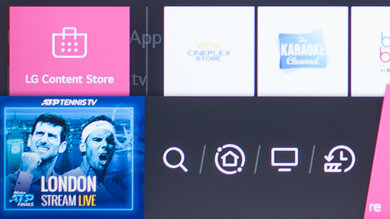The LG UN6970 is an okay overall 4k TV. It's a variant of the LG UN6950, but it's only available in a 75 inch size and sold exclusively at Best Buy. The picture quality is decent, and it displays 480p through 4k content without any issues. It has an IPS panel with wide viewing angles, but that comes at the cost of its contrast, so blacks appear closer to gray when viewed in the dark. HDR content also doesn't look good on this TV because it fails to display a wide color gamut and has low peak brightness, so highlights don't pop how they're supposed to. Casual gamers should be happy with its low input lag and quick response time, but it lacks many extra gaming features and is limited to a 60Hz panel. The LG WebOS interface is easy-to-use, the menus have smooth navigation, and there are a ton of apps available to download through the app store.
Our Verdict
The LG UN6970 is an okay overall TV. It performs best in wide seating arrangements as it has wide viewing angles. It displays lower-resolution content, such as from cable boxes, without any issues. It's good for gaming thanks to its quick response time and low input lag. However, it doesn't perform well in dark rooms due to its low contrast ratio. Also, it has low peak brightness and doesn't display a wide color gamut for HDR content.
- No issues upscaling lower-resolution content.
- Wide viewing angles.
- Incredibly low input lag.
- Low contrast ratio.
- Doesn't get bright enough to combat glare.
- Can't display wide color gamut.
The LG UN6970 is disappointing for watching movies. It has an IPS panel with a low contrast ratio and lacks a local dimming feature, so blacks appear gray when viewed in the dark. It also has disappointing black uniformity. Luckily, it upscales 1080p content very well and removes judder from native 24p sources.
- No issues upscaling lower-resolution content.
- Removes 24p judder.
- Low contrast ratio.
- Uniformity issues.
- No local dimming.
The LG UN6970 is decent for watching TV shows. It has wide viewing angles so that you can walk around while watching your favorite series without losing image accuracy. It also upscales 720p content, such as from cable boxes, without any issues. Sadly, it's not the best choice to use in well-lit rooms as it only has decent reflection handling and doesn't get bright.
- No issues upscaling lower-resolution content.
- Wide viewing angles.
- Decent reflection handling.
- Uniformity issues.
- Doesn't get bright enough to combat glare.
The LG UN6970 is decent for watching sports. You can easily watch the big game with a large group of friends because it has wide viewing angles. It also has a good response time, but there's still some image duplication with fast-moving content. Unfortunately, it doesn't get bright enough to combat glare and has only decent reflection handling if you want to use it in well-lit rooms.
- Wide viewing angles.
- Decent reflection handling.
- Good response time.
- Uniformity issues.
- Doesn't get bright enough to combat glare.
- Blacklight flicker results in image duplication.
The LG UN6970 is good for video gaming. It has a good response time that results in smooth motion and the input lag is incredibly low. However, it has a 60Hz panel and lacks variable refresh rate (VRR) support. Its IPS panel means it has a low contrast ratio and doesn't display deep blacks, but it has wide viewing angles if you want to use it for co-op gaming.
- No issues upscaling lower-resolution content.
- Good response time.
- Incredibly low input lag.
- Low contrast ratio.
- Blacklight flicker results in image duplication.
The LG UN6970 is disappointing for HDR movies. It has a low contrast ratio, disappointing black uniformity, and lacks local dimming, so blacks appear closer to gray when viewed in the dark. It also doesn't get bright enough to make highlights pop in HDR and fails to display a wide color gamut.
- Removes 24p judder.
- Low contrast ratio.
- No local dimming.
- Low HDR peak brightness.
- Can't display wide color gamut.
The LG UN6970 is okay for HDR gaming, mainly due to its good gaming performance. It has a quick response time and incredibly low input lag. Sadly, HDR content doesn't look all that different from SDR content. It has a low contrast ratio, low peak brightness, can't display a wide color gamut, and lacks local dimming.
- Good response time.
- Incredibly low input lag.
- Low contrast ratio.
- Low HDR peak brightness.
- Can't display wide color gamut.
The LG UN6970 is great to use as a PC monitor. It has wide viewing angles, so the image remains accurate at the sides if you sit too close. Also, it has low input lag, a quick response time, and it displays chroma 4:4:4. However, it doesn't get bright and has only decent reflection handling, so it doesn't perform well in bright rooms.
- Wide viewing angles.
- Decent reflection handling.
- Incredibly low input lag.
- Displays chroma 4:4:4.
- Doesn't get bright enough to combat glare.
- Blacklight flicker results in image duplication.
Changelog
- Updated Mar 02, 2021: Converted to Test Bench 1.6.
- Updated Nov 25, 2020: Review published.
- Updated Nov 23, 2020: Early access published.
- Updated Nov 02, 2020: Our testers have started testing this product.
Check Price
Differences Between Sizes And Variants
We tested the 75 inch LG UN6970, which is only sold at Best Buy in the United States for Black Friday and only available in this size. We tested the 50 inch model of the LG UN6950 variant sold at Walmart in North America, which is also available in more sizes; you can see them in the table below.
| Size | Panel | Best Buy | Walmart US |
| 43" | IPS | - | 43UN6950ZUA |
| 50" | VA | - | 50UN6950ZUF |
| 55" | IPS | - | 55UN6950ZUA |
|
65" |
IPS | - | 65UN6950ZUA |
| 70" | IPS | - | 70UN6950ZUA |
| 75" | IPS | 75UN6970PUD | 75UN6950ZUA |
If someone comes across a different type of panel or if their UN6970 doesn't correspond to our review, let us know and we'll update the review. Note that some tests, such as gray uniformity and contrast, may vary between individual units.
The unit we tested was manufactured in October 2020 and you can see the label here.
Popular TV Comparisons
The LG UN6970 is an okay overall TV that delivers good performance for its size and price. It's better overall than the LG NANO80, and if you have a wide seating arrangement, it's a better choice than some other budget-friendly models, such as the Hisense H6510G. However, if you prefer something with better contrast, there are other options available. Also see our recommendations for the best 70-75-77 inch TVs, the best 4k TVs, and the best budget TVs.
The Samsung TU7000 and the LG UN6970 are similar-performing TVs, but they have different panel types. The Samsung has a VA panel with a much better contrast ratio and significantly better black uniformity. It also has better gradient handling and a black frame insertion feature. However, the LG has an IPS panel with a wide viewing angle, gets brighter, has better reflection handling, and has a quicker response time.
The LG UN6950 is slightly better than the LG UN6970, but the units we tested have different panel types. The 50 inch UN6950 has a VA panel with a much better contrast ratio. It also has much better black uniformity and there's less stutter. However, the UN6970 has an IPS panel with wide viewing angles and it has better out-of-the-box color accuracy, but this may vary between units.
The LG UN6970 and the LG UN7000 perform very similarly overall. The UN6970 gets brighter in SDR, has wider viewing angles, and displays native 4k content perfectly. However, the UN7000 gets brighter in HDR and has better reflection handling.
The LG UN6970 is slightly better than the LG NANO80 2020. The UN6970 gets much brighter, has wider viewing angles, and a quicker response time. However, the NANO80 displays a wide color gamut and has better color accuracy.

We buy and test dozens of TVs yearly, taking an objective, data-driven approach to deliver results you can trust. Our testing process is complex, with hundreds of individual tests that take over a week to complete. Most of our tests are done with specially designed test patterns that mimic real content, but we also use the same sources you have at home to ensure our results match the real-world experience. We use two main tools for our testing: a Colorimetry Research CR-100 colorimeter and a CR-250 spectroradiometer.
Test Results

The LG UN6970 has a decent style. It looks like the LG NANO80, except the feet look similar to those on the LG UN6950. It's a simple TV made out of plastic and metal. The borders are thicker than most TVs in 2020 and may be distracting to some people but shouldn't be an issue for most.
The back of the LG UN6970 is exactly like the LG NANO80 with smooth metal. Sadly, there's no cable management.
The LG UN6970's contrast ratio isn't bad for an IPS panel, but blacks still appear gray when viewed in the dark. Also, contrast may vary between units. The 50 inch LG UN6950 variant of this TV that we tested has a VA panel and a much better contrast ratio.
The LG UN6970 has mediocre peak brightness. It's extremely consistent across different content, but it's not bright enough to combat glare in well-lit rooms. It gets brighter with the test patterns than the LG UN6950, but it doesn't get as bright in real scenes.
We measured peak brightness in the 'Expert (Dark Room)' Picture Mode with Backlight at its max and all other image processing disabled. If you want a brighter image and don't care about picture quality, we reached 317 cd/m² in the 2% window using the 'HDR Effect' Picture Mode.
The LG UN6970 doesn't have a local dimming feature. The video above is provided for reference only.
The LG UN6970 has disappointing HDR peak brightness. It's similar to the LG UN6950, except it's more consistent between scenes. However, it's not bright enough to make highlights pop how they're supposed to in HDR.
We measured HDR peak brightness in the 'HDR Cinema' Picture Mode with the Color Temperature set to 'Warm 2' and Contrast and Backlight at their max by default. We got the brightest image possible using these settings, as seen in the peak 100% window.
This TV has decent gray uniformity, but this may vary between units. The edges are visibly darker and there's dirty screen effect in the center, which can be distracting during sports. The uniformity is much better in near-dark scenes.
Our unit has disappointing black uniformity. The entire screen looks blue and there's clouding throughout. There's also backlight bleed along the edges, which can be distracting when watching movies in dark rooms. Note that black uniformity may vary between units.
The LG UN6970 has good, wide viewing angles, which is expected from an IPS panel. The image remains accurate when viewing from the side, so it's a good choice for wide seating arrangements. The 50 inch LG UN6950 variant of this TV that we tested has a VA panel and much worse viewing angles.
The LG UN6970 has decent reflection handling. It performs fairly well in moderately-lit rooms, but combined with its low peak brightness, it's best to avoid placing it in a room with direct sunlight.
The LG UN6970 has mediocre out-of-the-box color accuracy. Most colors are only slightly inaccurate, but it has a cold color temperature than results in a blue tint. White balance is off and gamma doesn't follow the target well, so most scenes are too dark, and really bright scenes are too bright. Note that out-of-the-box accuracy may vary between units.
The LG UN6970 has exceptional color accuracy after calibration. All color and white balance inaccuracies can't be spotted by the human eye, and gamma is almost perfect. The color temperature is closer to the 6500K target, but it's still on the cold side.
You can see our recommended settings here.
Like the LG UN7300, this TV uses an ADS (Advanced Dimension Switching) panel, which behaves like an IPS panel.
Similar to the LG UN6950, the LG UN6970 has a decent color gamut, but it's not considered a wide color gamut for HDR content. It has very good coverage of the DCI P3 color space used in most content, but it has limited coverage of the wider Rec. 2020.
The EOTF follows the target PQ curve fairly well, but some dark scenes are too bright. The EOTF in 'Game' mode is nearly the same, except the image is slightly less bright.
If you find HDR too dim, set Dynamic Contrast to 'High' and enable Dynamic Tone Mapping in the 'HDR Cinema' Picture Mode. This results in a noticeably brighter image, as you can see in this EOTF.
This TV has a disappointing color volume, mainly because of its lack of a wide color gamut and low contrast ratio. Also, it doesn't display colors at a wide range of luminance levels well.
The LG UN6970 has good gradient handling, similar to the LG UN6950. There's noticeable banding mainly in the darker shades, especially in dark gray. The Smooth Gradation feature doesn't do much on the test pattern but helps smooth out gradients in real content. However, setting it to 'Medium' or 'High' results in a noticeable loss of detail.
There are no signs of temporary image retention after displaying a high-contrast static image, but this may vary between units.
Although some IPS panels can suffer from temporary image retention, this doesn't appear to be permanent as seen in our long-term test.
The LG UN6970 uses Pulse Width Modulation (PWM) to dim its backlight at all brightness levels. It always flickers at 120Hz, exactly like the LG UN6950.
This TV doesn't have a Black Frame Insertion feature.
There's some stutter with lower-frame rate content due to the good response time, as each frame is held on longer. Turning on the motion interpolation feature helps smooth out motion and reduce stutter a bit.
The LG UN6970 can remove judder from native 24p sources such as native apps or Blu-ray players. To remove judder, simply enable Real Cinema.
This TV doesn't support any variable refresh rate technology.
The LG UN6970 has an incredibly low input lag as long as you're in 'Game' mode. It's slightly better than the LG UN6950, but it's almost impossible to notice any difference. It has an 'Auto Low Latency Mode' that automatically switches into 'Game' mode when you launch a game from a compatible device. For it to work, simply enable Instant Game Response.
If you want to use this TV as a computer monitor and want the lowest input lag possible, set the input icon to 'PC' and be in 'Game' mode.
This TV supports most common resolutions at 60Hz. It displays proper chroma 4:4:4 at all resolutions, which is important for reading text if you use it as a computer monitor. For it to display 4:4:4, change the input icon to 'PC' in the Home Dashboard. To get full-bandwidth signals, enable HDMI Ultra HD Deep Color.
This TV allows you to pass Dolby Digital audio via ARC or optical connection. For ARC connections, set Digital Input to 'Bitstream' and Output to 'Pass Through' in the sound settings.
The LG UN6970 has a mediocre frequency response. It has a well-balanced sound profile, which is good for listening to dialogue. Unfortunately, it doesn't get loud and doesn't produce much bass either.
The distortion performance is okay. There's some distortion at moderate listening levels, and even though it gets more noticeable at its max volume, most people may not hear it and it depends on the content.
This TV runs on the same LG WebOS found on other high-end LG TVs. It's easy-to-use, and it's fairly smooth to navigate the menus. We didn't experience any bugs during testing.
The LG UN6970 has the same basic remote as the LG UN6950. The Amazon Prime Video quick-access button actually has the Amazon branding, which it didn't have on the LG UN6950 and was just an unlabeled button. Sadly, there's no voice control.


